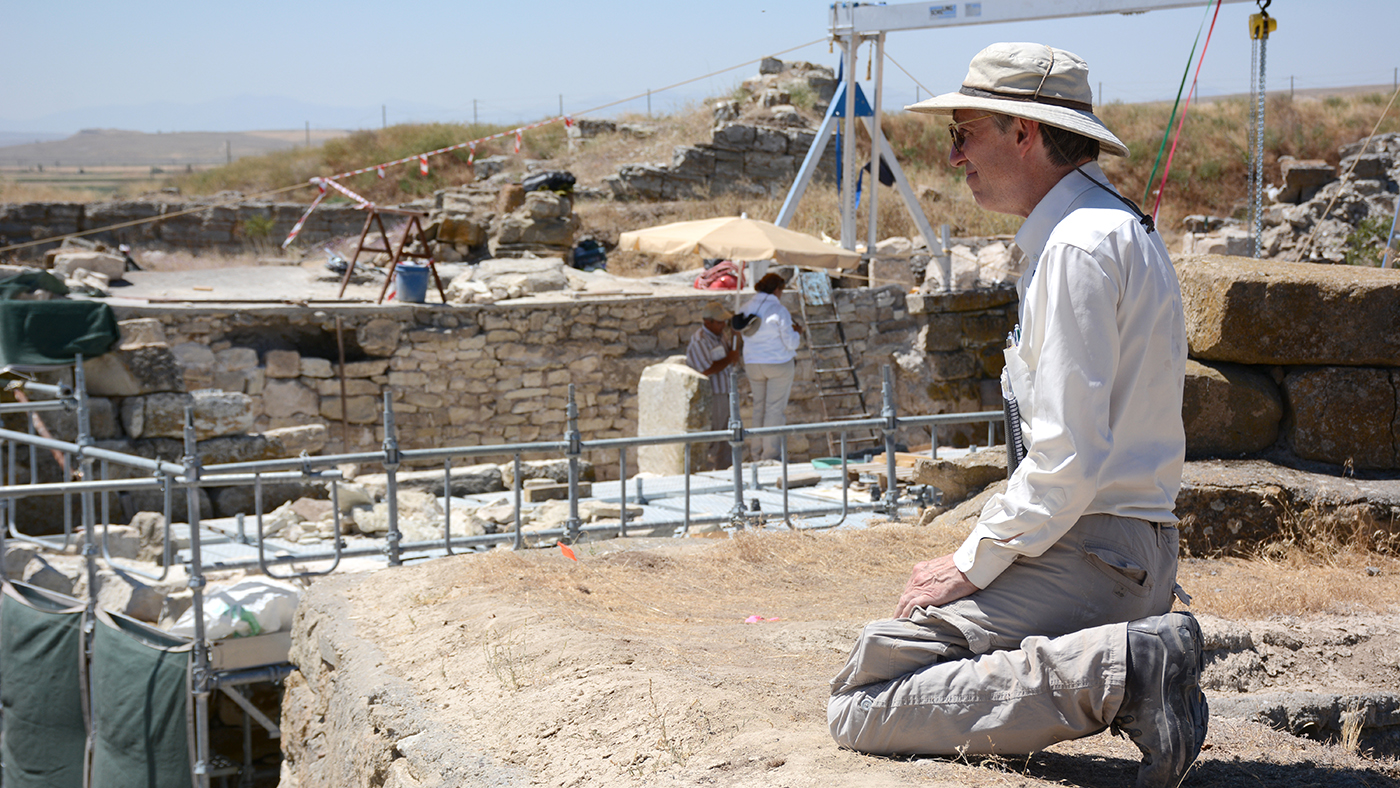Gordion, First Active Penn Museum Archaeological Site Named in UNESCO World Heritage List

PHILADELPHIA, September 19, 2023—Gordion, Türkiye has been designated as a United Nations Educational, Scientific, and Cultural Organization (UNESCO) World Heritage Site—the first site under active excavation by the Penn Museum to be added to the list. The announcement occurred during the 45th World Heritage Committee meeting in Riyadh, Saudi Arabia, officially recognizing Gordion's longstanding cultural and archaeological significance.
With a rich history spanning over 4,000 years, from the Early Bronze Age (2,400 BCE) to the Medieval period, the ancient city of Gordion reached its peak in the Iron Age (ca. 900-600 BCE). During this period, it served as the royal capital of the powerful kingdom known as Phrygia to the Greeks and Mushki to the neighboring Assyrians. Occupying a strategic position on the Sangarios (Sakarya) river in central Türkiye, Gordion played an important role in the trade routes linking the Aegean and Mediterranean with the Near East. During the Bronze and Iron Ages, this commercial activity brought the city into contact with the Hittites, Neo-Hittites, Assyrians, Urartians, Lydians, and Greeks, and later with the Persians and the Romans.
More than 70 years of archaeological excavations at Gordion have uncovered remarkable evidence of advancements in human history—from the first decorated stone mosaics ever found to examples of extraordinary achievements in carpentry, including the oldest standing wooden building in the world, dated to 740 BCE. Investigations at Gordion have revealed that the fabled King Midas, in later Greek mythology cursed with the "golden touch," was an actual historical figure who ruled from Gordion during the 8th century BCE. New discoveries also support the story that Alexander the Great traveled to Gordion in 333 BCE and cut the proverbial "Gordian knot," thereby fulfilling the prophecy that whoever did so would rule Asia. The project has also uncovered a wealth of information about ancient construction techniques, defensive architecture, and cult practices of the Phrygians, as well as key developments in the economic life of the city.
Gordion features monuments of outstanding archaeological significance, such as the best-preserved Iron Age Citadel Gate in Asia Minor, elaborately carved wooden furniture, and 130 monumental burial mounds that surround the citadel. The largest of these, Tumulus MM, probably contained the body of King Midas' father Gordias, and, with a height of 53 meters, it is the third largest burial mound in the world.
The first series of excavations led by the University of Pennsylvania began in 1950 with Rodney S. Young, former curator-in-charge of the Penn Museum's Mediterranean Section. An international collaboration of field experts, conservators, and Penn students led by Project Director Dr. C. Brian Rose since 2007, the Gordion Archaeological Project works in partnership with the Turkish Ministry of Culture and Tourism, which assumes ownership of all materials excavated from the site, and the Museum of Anatolian Civilizations in Ankara. Dr. Rose and the Turkish Cultural Ministry submitted a 366-page nomination for the UNESCO designation during the fall of 2020.
"The new UNESCO designation will enable us to accelerate the protection of the archaeological site and its monuments, while increasing the number of visitors who come to Gordion," says Dr. C. Brian Rose, Ferry Curator-in-Charge of the Mediterranean Section of the Penn Museum and James B. Pritchard Professor of Archaeology in the Department of Classical Studies at Penn's School of Arts and Sciences. "I want to acknowledge the overwhelming support that we received from the Turkish Ministry of Culture and Tourism, from Ankara's Museum of Anatolian Civilizations, and from the municipality of Polatlı."
According to UNESCO guidelines, Designated World Heritage Sites are natural or cultural locations demonstrating influence or meaningful significance, offering outstanding universal value, and transcending national boundaries, which are protected for future generations of all humanity.
The Penn Museum continues its efforts to protect cultural heritage around the globe through its archaeological work in the field, public policy engagement, community partnerships, and through the international initiatives of the Penn Cultural Heritage Center.
"Gordion is one of the most important and the longest-running of the Penn Museum's archaeological sites, and we are so grateful to our partners in Türkiye for the opportunity to work there," says Dr. Christopher Woods, Williams Director of the Penn Museum and Avalon Professor in the Humanities at Penn's School of Arts and Sciences. "UNESCO inscription is a wonderful acknowledgement of the site's major significance and the incredible work our researchers and Turkish partners have done there for more than seven decades."
On December 6 from 7:00 to 8:30 pm ET, the public is invited to learn more about the Gordion Archaeological Project directly from Dr. Rose in his virtual lecture, "Archaeology in Action: Excavating the Royal City of Midas," as he discusses this extraordinary site and the journey to protect its cultural heritage. $15 general and $7 member tickets are available through online registration here.
Editor’s note: Hero image is available for download here. Additional images are available for download here.
###
About the Penn Museum
The Penn Museum’s mission is to be a center for inquiry and the ongoing exploration of humanity for our University of Pennsylvania, regional, national, and global communities, following ethical standards and practices.
Through conducting research, stewarding collections, creating learning opportunities, sharing stories, and creating experiences that expand access to archaeology and anthropology, the Museum builds empathy and connections across diverse cultures
The Penn Museum is open Tuesday-Sunday, 10:00 am-5:00 pm. It is open until 8:00 pm on first Wednesdays of the month. The Café is open Tuesday-Thursday, 9:00 am-3:00 pm and Friday and Saturday, 10:00 am-3:00 pm. On Sundays, the Café is open 10:30 am-2:30 pm. For information, visit www.penn.museum, call 215.898.4000, or follow @PennMuseum on social media.
Through conducting research, stewarding collections, creating learning opportunities, sharing stories, and creating experiences that expand access to archaeology and anthropology, the Museum builds empathy and connections across diverse cultures.



